Cashew Farming Detailed Information Guide
The following content details about Cashew Farming Techniques, Ideas, and tips.
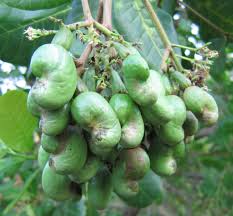
Introduction to Cashew:
Cashew nut is native of Brazil, was introduced in India during the latter half of the Sixteenth Century for the purpose of afforestation and soil conservation. From its humble beginning as a crop intended to check soil erosion, cashew has emerged as a major foreign exchange earner next only to tea and coffee. Cashew nut is one of the important nuts grown in the world and ranked first. Among various nuts such as hazelnuts, almonds, etc., cashew nut enjoys an unenviable position and it is an unavoidable snack in all important social functions especially in the western countries.
Farming of Cashew and its Importance:
Commercial cultivation of cashew is taken up in eight states of our country mainly in west and eastern coast viz., Andhra Pradesh, Goa, Karnataka, Kerala, Maharashtra, Orissa, Tamil Nadu, and West Bengal. In addition, cashew is also grown in few pockets of Assam, Chhattisgarh, Gujarat, Meghalaya, Nagaland, and Tripura. India has an area of 9.53 lakh ha (2010-11) under cashew with an estimated annual production of about 6.74 lakh tonnes of raw cashew nut. India is the third largest producer and exporter of cashew in the world next only to Vietnam and Nigeria. It is the second largest consumer of cashew and also the biggest processor with the highest acreage under the crop. The current cashew production of the country accounts for 23.0% of the global production. A large number of small and marginal farmers, especially living on the coastal belts of India, depend on cashew for their livelihood. Nearly 2.00 lakh workers, more than 90% of whom are women, are directly employed in cashew processing factories which are concentrated mostly in Kerala, Andhra Pradesh, and Maharashtra. It is estimated that nearly two million people are involved, directly and indirectly in cashew cultivation, processing, and marketing.
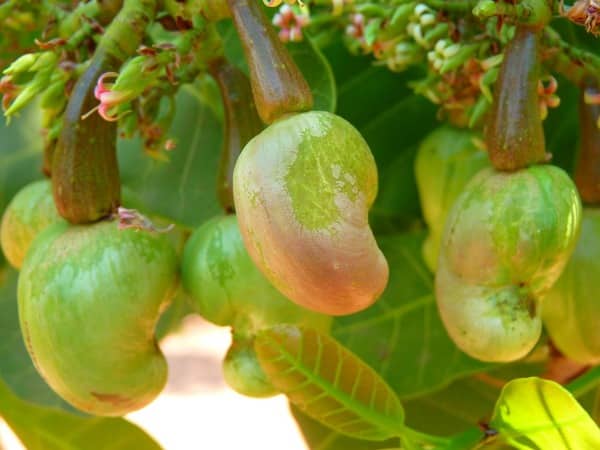
Suitable Soil for Cashew Plantation:
In growing Cashews, the general notion is that “cashew is very modest in its soil requirements and can adapt itself to varying soil conditions without impairing productivity”. While Cashew can be grown in poor soils, its performance would be much better on good soils. The best soils for cashew are deep and well-drained sandy loams without a hardpan. Cashew also thrives on pure sandy soils, although mineral deficiencies are more likely to occur. Water stagnation and flooding are not congenial for cashew. Heavy clay soils with poor drainage and soils with pH more than 8.0 are not suitable for cashew cultivation. Excessive alkaline and saline soils also do not support its growth. Red sandy loam, lateritic soils and coastal sands with slightly acidic pH are best for cashew.
Climatic Requirements for Cashew Production:
Cashew is a tropical plant and can thrive even at high temperatures. Young plants are sensitive to frost. The distribution of cashew is restricted to altitudes up to 700 m above mean sea level where the temperature does not fall below 20°C for a prolonged period. Areas where the temperatures range from 20 to 30°C with annual precipitation of 1000 – 2000 mm are ideal for cashew growing. However, temperatures above 36°C between the flowering and fruiting period could adversely affect the fruit setting and retention. Heavy rainfall, evenly distributed throughout the year is not favorable though the trees may grow and sometimes set fruit. Cashew needs a climate with a well-defined dry season of at least four months to produce the best yields. The coincidence of excessive rainfall and high relative humidity with flowering may result in flower/fruit drop and heavy incidence of fungal diseases.
Read: Guava Grafting Methods; Pruning Methods.
Preparation of Land for Cashew Plantation:
The land should be plowed thoroughly and leveled in case of agricultural lands. In the case of forestlands, the jungle should be cleared well in advance and the debris burned. After clearing the jungles, the land is to be terraced or bunds constructed on sloppy land. In order to ensure better moisture conservation, soil trenches are dug across the contours. The cost of land preparation will vary depending upon the type and method of soil working. Nowadays, the use of JCB for soil working is most popular; hence a provision for use of soil working is made in the model. The land preparation work should be completed prior to the onset of monsoon season i.e. during May – June.
Plantation Procedure of Cashew Crop:
Fresh seeds that sink in water are planted in an upright position in a planting bag containing a loose, sterilized soil mixture. 3 to 4 seeds can be planted directly in the planting hole. The weakest ones are thinned out later and the strongest left to develop further. The seedlings are very susceptible to Phytophthora root rot. The plant bags should be 350 to 400 mm deep, as the tap-root grows very fast and bends around as soon as it touches the bottom.
Planting Space of Cashews:
Planting space of 8 m x 5 m is recommended. The trees grow vigorously in the first 3 years and as soon as the crowns touch each other alternate trees should be removed until the permanent planting distance of 10 to 12 m is reached. Branches hanging on the ground should be removed because they interfere with harvesting. In other parts of the world, cashew trees bear well, in spite of the little attention devoted to the orchards.
Digging and filling of pits for Growing Cashews:
The work of digging of pits has to be completed much in advance (May – June). Cashew can be planted in pits of 60cm x 60cm x 60cm size in soils with normal strata. In hard lateritic soils, pits of 1m x 1m x 1m size are recommended. The topsoil and sub-soil are kept separately and allowed to wither under the sun. It helps in the migration of termites and ants. Burning of the debris and forest wastes inside the pits before planting is advantageous. The pits are then filled with topsoil mixed with farmyard manure or compost (5 kilograms) or poultry manure (2 kilograms) and rock phosphate (200 grams). In order to mitigate soil-borne diseases, BHC @ 100 grams/pit is also added to the soil mixture.
Grafting method of Cashew Plants:
Two grafting techniques, namely side grafting, and wedge grafting are practiced with success. Grafting should commence as soon as possible (seedlings of 3-4 months old) and planted out in the orchard to prevent the tap-root from bending.
Seedlings of Cashew::
Cashew seedlings are grown under shade (45 %) and hardened off before planting in the orchard. It is very important not to disturb the root system during planting. Young trees should be supported for the first 2 to 3 years so that wind will not blow the plants over.
The mulching requirement for Cashew Plantation:
In Cashew cultivation process, the cashew is generally planted on the wastelands and hence the availability of soil moisture is always low, hence, mulching is essential. Mulching with black polythene is beneficial to increase the growth and yield of cashew. However, locally available materials like green or dry grass or weeds can be utilized for mulching the basins. Small pebbles or stones can also be used for mulching of the basin. The plastic or stone mulch does not improve soil health but ensures better moisture retention in the soil and also prevents the attack of soil-borne insects and pests.
Irrigation requirement of Cashew Plants:
In Cashew production, irrigation is an important factor during the establishment of young trees because it doubles the growth tempo of young trees in a dry season. Due to the deep root system, the trees can survive several months without irrigation. Mature trees should receive 1800 liters of water per tree every 2 weeks.
Application of Manure and Fertilization in Cashew Crop
In India, the application of manures and fertilizers is very limited in the case of Cashew. In order to get better yield, it is essential to maintain adequate N:P:K ratio in the soil. Application of 10-15 kg of farmyard manure per plant is recommended to ensure adequate organic matter in the soil. The fertilizers recommended for a mature cashew tree are 500 g N (1.1 kg urea), 125 g P2O5 (750 g Single Super Phosphate and 125 g K2O (200 grams muriate of potash). The nutritional requirements and the quantity of fertilizer per plant are given in Table 2. Table 2. Nutritional requirements and recommended fertilizer doses for cashew Age Urea (g) SSP (g) MOP (g) 1 st Year 375 275 75 2nd year 750 525 150 the 3rd year 1100 750 200 The ideal time for application of fertilizer is immediately after the cessation of heavy rains. Fertilizers should be applied in a circular trench along the drip line. Before the application of fertilizer, it should be ensured that there is adequate soil moisture.
In Cashew crop, the fertilizers should be applied in two split doses during pre-monsoon (May – June) and post-monsoon (September – October) season. However, in the case of a single application, it should be done during the post-monsoon season (September – October) when adequate soil moisture is available. In sandy and laterite soils, soils of sloppy land and in heavy rainfall zones, the fertilizer application should be done in a circular trench of 25 cm width and 15 cm depth at 1.5m from the tree trunk. In red loamy soils and in low rainfall areas (east coast), the fertilizers should be applied in circular bands at a distance of 0.5m, 0.7m, 1.0m and 1.5m away from the trunk during first, second, third and fourth year onwards of planting, respectively.
Weed Control in Cashew Plantation:
In Cashew crop, weeding with a light digging should preferably be done before the end of rainy reason. Hoeing, cutting the weeds off the underground is more effective than slashing. Chemical weeding has not been of any importance until now, however, it may be considered as an alternative, where wages are high or where there is a shortage of labor. Initially, Agrodar-96 (2, 4 –D) @4ml/liter of water and subsequently Gramaxone @5ml/liter of water is sprayed. Approximately, 400 liters/ha (160 liters/acre) of a solution is required per spray. The spray is again repeated in the post-monsoon season.
Inter-cropping in Cashew Orchard:
In Cashew plantation, tall growing intercrops like certain varieties of sorghum and millet should not be encouraged between young cashew, as they provide too much shade. Leguminous crops such as groundnut and beans are very suitable for intercropping. Besides the annual crops, arid zone fruit crops having less canopy especially Annona, phalsa, etc., can be thought of, depending on the suitability. Cultivation of horse gram, cowpea, groundnut, etc is recommended as inter-crops in cashew. Intercropping cashew, Casuarina, and coconut are popular.
Read: Cashew Farming Project Report.
Cover cropping in Cashew Production:
In Cashew production, leguminous cover enriches the soil with the plant nutrients and adds organic matter, prevent soil erosion and conserves moisture. The seeds of these cover crops may be sown at the beginning of the rainy season. The seedbeds of 30cm X 30cm size are prepared in the interspace in slopes by loosening soil and mixing a little quantity of compost. The seeds of these crops are sown in the beds and covered with a thin layer of soil. The seeds should be soaked in the water for six hours before sowing.
Training and Pruning in Cashew Plants:
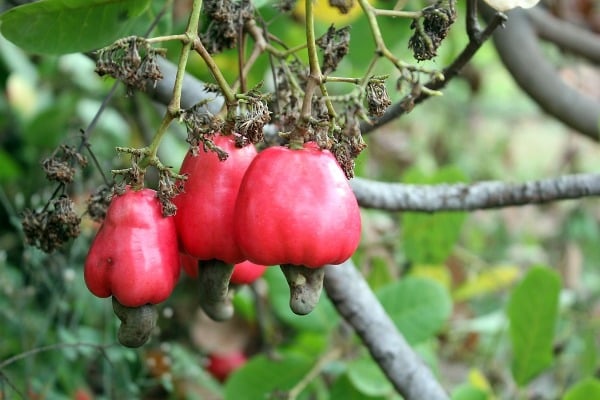
In Cashew cultivation, during the first year of planting, the sprouts coming from the rootstock should be removed frequently to ensure better health of the plant. These sprouts eat up valuable plant nutrition and also cause the death of grafted scion allowing the only rootstock to grow. Initial, training and pruning of cashew plants during the first 3-4 years is essential for providing proper shape to the trees. The trees are shaped by removing lower branches and water shoots coming from the base during the first 3-4 years. Thereafter, little or no pruning is necessary.
The plant should be allowed to grow by maintaining a single stem up to 0.75-1.0 m from the ground level. Weak and criss-cross branches are also chopped off. In order to avoid lodging of the plant by wind, proper staking of a plant is essential. After 4-5 years, the main stem is de-topped to a height of 4-5 m from the ground level. Thereafter, regular removal of dried/ dead wood, criss-cross branches and water shoots once in a 2-3 year is done to keep the plant healthy. The training and pruning of cashew plants are done during August – September. The cut surfaces are smeared with Bordeaux paste. The flowers appearing during the first and second year of planting should be removed (de-blossoming) and plants should be allowed to bear fruits only after the third year.
Read: Major Paddy Insect Pests.
Pests and Diseases of Cashew Plants:
In Cashew Farming, It is observed that there are about 30 species of insects infesting in cashew farming. Out of this tea mosquito, flower thrips, stem and root borer and fruit, and nut borer are the major pests, which are reported to cause around 30% loss in yield of cashew nut. Basically, cashew crop does not have any serious disease problem except the powdery mildew caused by a fungus, which affects the young twigs and inflorescence and makes it wither. This disease generally appears when the weather becomes cloudy. Control can be obtained by dusting with 2% sulfur W.P.
Flowering to Harvesting time of Cashew:
In Cashew Farming, flowering is affected by weather conditions and also varies from tree to tree, but continues for a period of 3 months. High temperatures lead to earlier flowering. Both male and bisexual flowers are borne on one cluster. The flowers are very susceptible to mildew and control thereof on the leaves and flowers is a prerequisite for good production.
Pollination is mostly by insects. After pollination, it takes 6 to 8 weeks for the fruit to develop. The nut develops first while the apple develops and enlarges only 2 weeks before fruit fall. Nuts should be harvested as soon as possible, especially under wet conditions and should be dried before storage
Harvesting, Yield, and Marketing of Cashew:
In Cashew Farming, cashew plants start bearing after three years of planting and reach full bearing during the tenth year and continue giving remunerative yields for another 20 years. The cashew nuts are harvested during February – May. Normally, harvesting consists of picking of nuts that have dropped to the ground after maturing. However, if the apples are also used for making jam, juice, syrup, Fenni, etc., the fruit has to be harvested before it falls naturally. The cashew apples are removed and the nuts are dried in sun for 2-3 days to bring the moisture level from 25 percent to 9 percent. The maturity of the cashew nut is tested by the floatation method.
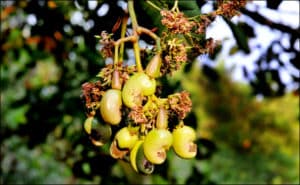
The mature nuts sink in water while the immature/ unfilled ones float. The nuts are collected at weekly intervals from the farm during the harvesting season. During that period the land should be clean in order to facilitate the collection of cashew. Plantations of unknown origin or seedling progenies with conventional methods of cultivation yield less than one kg of raw nuts per tree. However, there is a chance to increase the yield up to 4 to 5 kg per tree with the adoption of improved production techniques, over a period of 4 to 5 years. In new plantations, with the use of elite planting material coupled with a package of improved agronomic practices, a yield of 8-10 kg per tree could be achieved. 3.18 Marketing Marketing of raw cashew is not a problem in view of the fact that our raw material production is considerably low (around 6.74 lakh t) when compared to the processing capacity of our existing factories (around 7.0 lakh t developed so far). The raw cashew nuts fetch a price of Rs.65-70 per kg in the internal market.
Processing of Cashew:
This involves the following steps 1) Preliminary cleaning 2) Roasting 3) Shelling 4) separation 5)Drying 6) Peeling.
Grading and Packaging:
Kernels, whole and broken, are sorted into 6 grading schedules. There is only a small demand for broken or dark and unevenly roasted kernels. Kernels are dried to 3 % moisture content before they are packed. Drying is necessary to extend shelf life and prevent fungal and other infections. Dried kernels do not become rancid. Nut kernels of export quality are vacuum packed in tins.
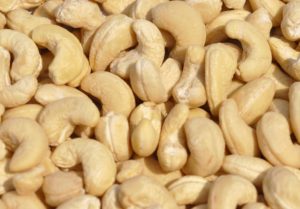
Read: How to Grow Swiss Chard.
Marketing of Cashew:
Marketing of raw cashew in India is not a problem because of the fact that our raw material production is considerably low (around 6.74 lakh t) when compared to the processing capacity of our existing factories (around 7.0 lakh t developed so far). The raw cashew nuts fetch a price of Rs.65-70 per kg in the internal market
Bottom Line of Growing Cashews:
Cashew farming is profitable with proper orchard management practices. That’s all folks about cashew farming techniques, planting methods and harvesting process.
Read: HF Cow Facts.
Thank you for your more valuable information. Sir there is a 5 acre cashew nut farming in my own land. Last year we collected approximate 10 quintal raw cashew nuts. But some trees which provide more cashew nuts suffered by some disease which is not known by me.The disease is like there are some blackish brown pests are over the main stem and after one year the tree was completely dead.
Please give some advice regarding the treatment of above.
Well, there may be many reasons why the healthy cashew nut trees are dead. One has to analyse the symptoms of the tree before suggesting any fertigation. You better contact your local horticulture department for symptoms and disease control methods.
We don’t have phone support. you can post your comments or questions here at Agri Farming.
Its good to read your writings. I will be very pleased if you sincerely let me know how to grow them as I have collected 3 seeds with all difficulty faced! The month and everything involved…. Thanks
Did you read about how to grow seedlings from seeds?
I am Emmanuel From Uganda looking for seeds for cashew nuts.
We don’t sell any vegetable seeds, fruit seeds or any agriculture produce.
Can I grow/propagate cashew nut plant from it’s cuttings with or without using any rooting hormone? Also, can the Aloe Vera gel extracted from it’s leaf be used as a natural rooting hormone?
In my cashew farms flowers blooms In the East side of the trees. In other sides of the trees no result.
What’s the problems?
Greetings,
My name is Aliasgar and I come from Tanzania. The purpose of this message is that I need some professional advice on the processing of cashew nuts. What are your opinions and advices about this situation and please provide me with information on which machinery to buy. I will be waiting for your prompt reply.
Thank you.
Well, You can read about: Cashew Nut Farming Project Report.
Sir, I Want To Know Uttar Pradesh (Sultanpur Distt) Is Suitable For Cashew Farming?
Check this project report for suitable soil and climate: Cashew Nut Farming Project.
Sir Where can we get cashew nut seeds for planting?
Good day, I’m from South Africa.
I’m looking for cashew nut seeds that I can buy to grow. I’ve bought on ebay, but those are definitely not cashew nut seeds.
Can you please assist me in this matter? I can’t seem to find them anywhere. I own a small business where I’m growing and selling all kinds of trees and plants and I would like to buy 300 seeds.
Thank you.
Laurika Veldhoën
Quite informative
Hi ,
Can we get a tour of whole process in person?